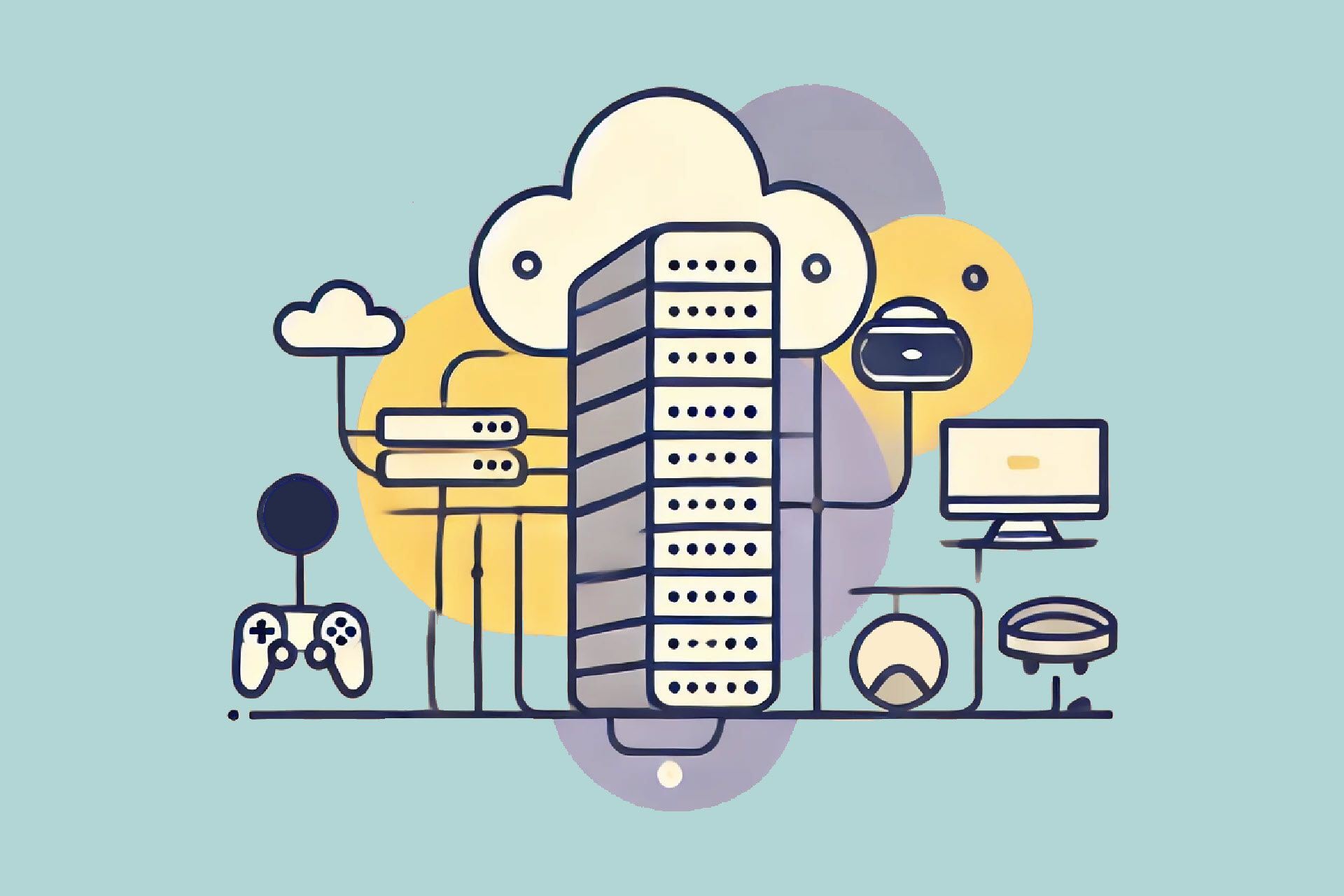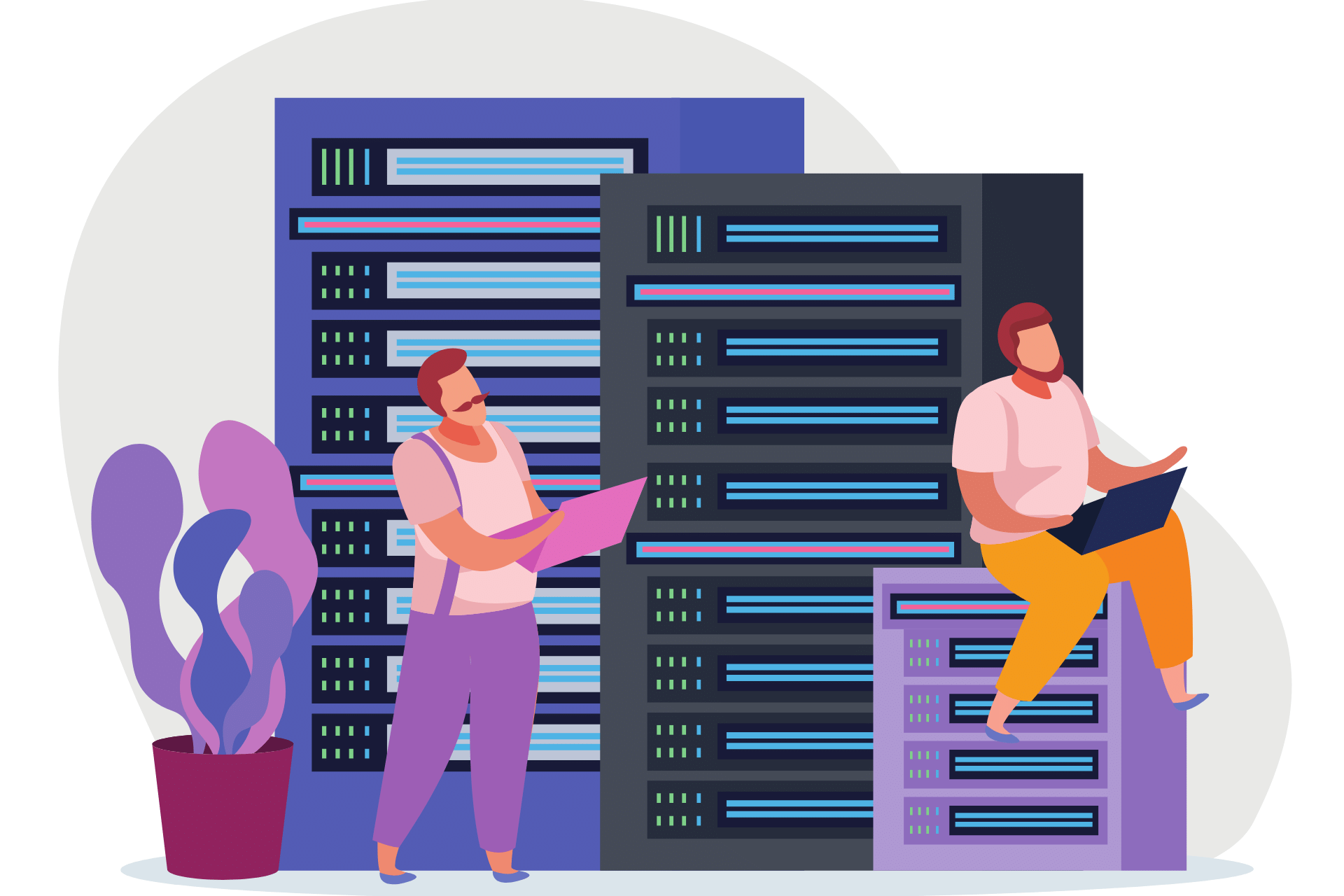On-prem hosting is still a worthwhile option for some businesses, but creating an effective server room design is often challenging. Unfortunately, a poorly planned-out server room leads to more issues than benefits. Instead of enjoying high customization and total control over your IT, you get hardware failures, out-of-control expenses, and costly downtime.
This article explains what it takes to create a well-rounded server room design and offers 10 best practices that ensure on-site hosting leads to a high ROI. Read on to learn everything your team needs to account for when setting up a new or trying to improve an existing server room.
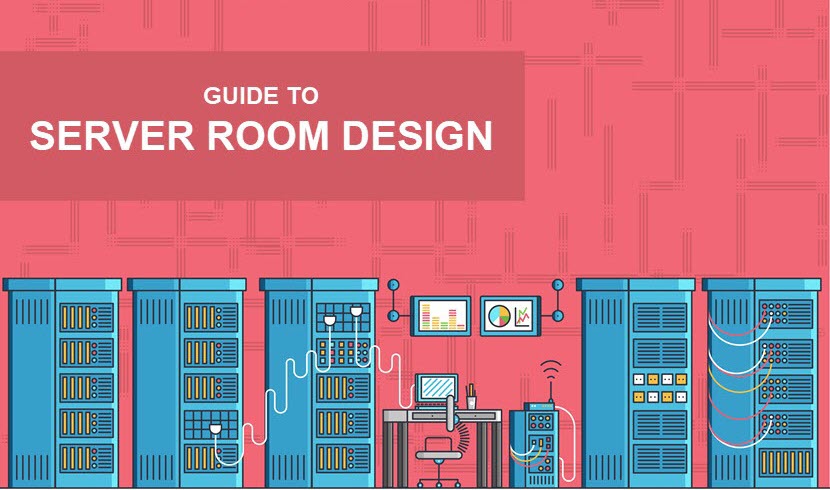
Important Server Room Design Aspects
A server room is an on-site space dedicated to the operation of computer servers, data storage, and networking equipment. Whereas a classic data center serves the same purpose for multiple clients (hundreds or even thousands), a server room typically supplies IT resources to a single organization.
A server room design must take into consideration various aspects to operate correctly. Regardless of whether it fits into a single cabinet or takes up the majority of your office space, a server room must have:
- Enough network connectivity and bandwidth for smooth operations.
- Sufficient server capacity to meet the organization's storage needs.
- Enough physical space to house all necessary IT equipment (both now and in the future).
- Controls and sensors that help keep temperature and humidity at an acceptable level.
- Proper airflows that prevent hot spots and eliminate heat-caused damage to hardware.
- Fire suppression systems that can put out the flame without spraying water.
- A redundant power source that ensures the equipment stays up and running even if the primary power source goes down.
- Seismic protection that prevents equipment damage in case of an earthquake.
- Physical security measures that keep the server room safe from external and insider threats.
- Top-tier cybersecurity measures that prevent cyberattacks.
If an on-site server room seems too complex or expensive to set up, relying on a hosting provider is likely the better option. Our articles on data center selection and data center outsourcing (DCO) take you through all you need to know about choosing a suitable third-party facility.
Server Room Main Equipment
Every server room houses unique gear, but there are pieces of hardware you can expect to find in any on-site hosting environment. Below is a list of equipment you can expect to see in every server room:
- Computer servers: Servers are an integral part of every server room. Depending on your IT specifications, you can host stand-alone servers, blade servers, or even equipment for virtual servers. Most privately owned facilities house dedicated servers.
- Racks: Server and computer racks house, power, and protect IT gear. A cabinet can have different rack densities (the amount of power the equipment within a rack uses) depending on how power-hungry your equipment is.
- Routers and switches: Networking equipment enables the system to send, receive, and route the data that comes in and out of a server room. Keeping routers and switches safe is a vital aspect of network security.
- Network cabling: A server room typically has multiple types of network cabling (CAT-5 and fiber optic cables are the two most common options). Most rooms also have cable management equipment such as zip ties and eyelets that help organize cables.
- Environmental monitors: Sensors take temperature and humidity readings to monitor the server room and alert technicians in case of an incident.
- Air cooling equipment: Every server room has a device that maintains an optimal temperature. Technicians can set up commercial air conditioners, water coolers, or more advanced solutions such as direct liquid cooling.
Do you already have IT equipment but do not wish to deal with an on-prem server room?
PhoenixNAP's colocation services enable you to set up your hardware at one of our facilities and enjoy top-tier networking and redundancy without high upfront costs.
Server Room Design Best Practices
Whether you are setting up a server room from scratch or looking to improve an existing one, the 10 best practices listed below can ensure your server room design is as bulletproof as possible.
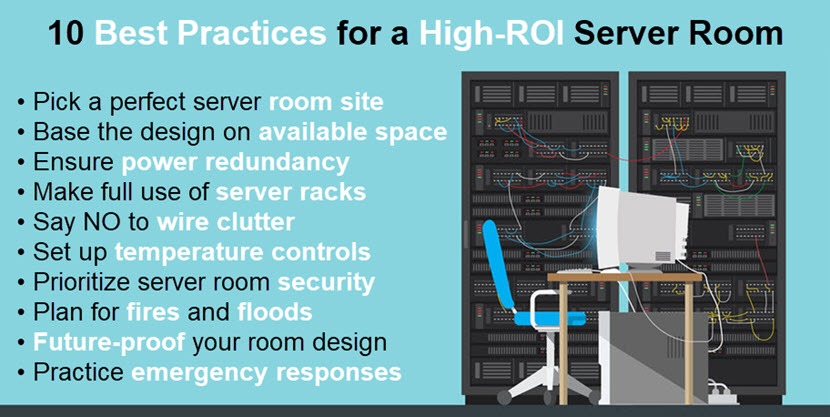
Pick a Perfect Site for the Server Room
Keep the following in mind when deciding where to set up a server room:
- A server room should have no exterior walls to avoid heat and the potential impact of a natural disaster (e.g., a wildfire or a tsunami).
- The room must have sufficient floor loading capability to handle the pressure of heavy bare metal servers.
- Server rooms require large doors for equipment access and ramps that enable staff members to get hardware in and out.
- Keep your hardware out of basements or top floors to avoid leaks and moisture issues.
- The walls must not have water pipes that could burst and drench the system.
- Ideally, the server room should have no windows. If you cannot avoid having a window, it must be double or triple-glazed and shaded to prevent direct sunlight.
- You should keep your server room away from any dangerous goods storage.
- There should be no nearby mechanical shocks or excessive vibrations. You should also set up a server room away from electromagnetic interference (e.g., a generator).
- Try to place your server room as close to the center of the office as possible. A central location simplifies the distribution of cables from the server room across the office.
- The ceiling height must accommodate duct ventilation and the size of server racks.
- Keep in mind that your in-house staff needs a well-lit workspace near the server room in which they can monitor the facility and perform hardware tweaks.
The safeguards listed above barely scratch the surface of what it takes to keep a full-blown data center safe. Our article on data center security goes through all precautions providers rely on to protect their facilities.
Know With How Much Space You Are Working With
A server room can be virtually any size. Whereas some businesses devote half of the office space to servers, others make do with one or several cabinets spread across the facility.
While you have options, you need to know the dimension of the space you plan to dedicate to servers. You should then plan your server room design, layout, and hardware inventory accordingly.
Most companies attempt to keep their server room as small as possible, but keep in mind that:
- Underutilizing space can cause operational inefficiencies.
- Overutilizing space leads to added costs or even hazardous events.
If you decide to devote office space to a server room, our server management article offers a handy overview of all the tasks your in-house team will need to perform.
Ensure Power Redundancy
If your server room hosts mission-critical apps or data, removing single points of failure is vital to avoiding downtime. An uninterrupted power supply (UPS) ensures a server room always has power, even during interruptions such as region-wide blackouts.
The batteries of a UPS system keep equipment (and, by extent, your business) running until the power comes back on. Most UPS solutions can keep a server room going for 5 to 20 minutes, after which your backup generator should take over.
Here are the most common options for ensuring on-site power supply redundancy:
- A diesel or a gasoline power generator.
- A natural gas power generator.
- A second feed line from an additional power station.
As an added benefit, a UPS protects your servers during power surges (the number one cause of damaged hosting equipment). A power surge may require your team to repair or replace hardware, which costs money and compromises service availability.
For extra protection against surges, consider also setting up a rack power distribution unit (rPDU) that ensures every piece of hardware always gets the right amount of power.
Your team should also ensure that you do not overload the UPS. The more infrastructure you add and the higher your rack density is, the server room consumes more power. If the UPS cannot keep up with the demand, your team will have less time to start the backup generator.
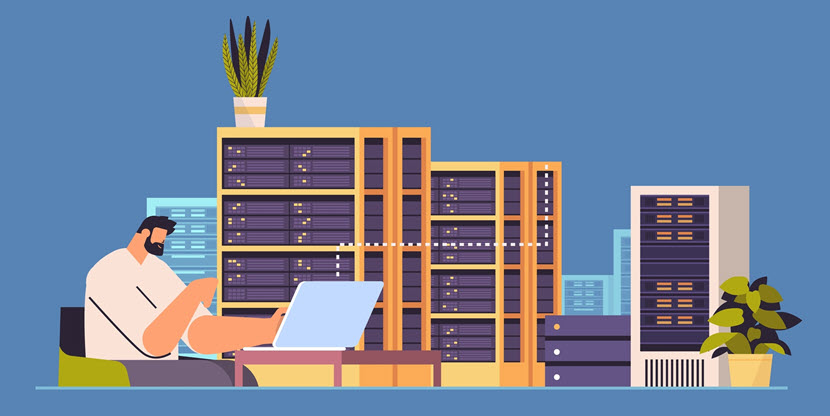
Make Full Use of Server Racks and Cabinets
When creating a server room design, server racks are your team's most valuable asset. A rack helps:
- Organize servers, cables, and wires.
- Maintain a stable temperature of housed hardware.
- Protect IT gear from physical damage.
- Set up and use UPS units and rPDUs.
- Contain some of the noise a server makes.
Companies choose racks and cabinets based on:
- Allocated budget.
- Size (typically measured in rack units (RU or U) that signify how many servers can fit inside).
- Type.
- Cooling and power distribution mechanisms.
- Unique security features (e.g., a door with a built-in biometric scanner).
- How easily portable the rack is.
- How resistant the cabinet is to water and dust.
Most organizations creating a server room design opt for telco racks or enclosed cabinets to make the most of their space. Luckily, with the latest servers (mainly one-rack-unit (1U) and new blade servers), a single 19 or 23-inch rack can accommodate anywhere from 42 to hundreds of servers.
Avoid Wire Clutter
Efficient routing of wires and cables is vital to the safety of your server room. Sloppy, disorganized clutters of wires are an accident waiting to happen, so ensure your team:
- Uses zip ties and eyelets to organize and keep cables safe.
- Creates proper pathways where wires and connections can travel without the risk of somebody tripping over them.
- Maps connections so IT techs can quickly identify and access trouble spots.
- Removes cables when they no longer have any use.
Another way to avoid wire clutter is strategically setting up switches and other network gear to minimize cable lengths. Well-organized cables are also critical to your staff's ability to respond to incidents promptly.
Take Temperature Control Seriously
Maintaining a stable temperature is critical to server reliability. Aim to keep the room temperature between 68 and 71°F (20-22°C).
Modern server room designs rely on precision air conditioning (PAC) systems that control temperature, humidity, and particle filtration. PACs operate 24/7, automatically react to environment changes, and enable remote monitoring.
Here are a few good practices for ensuring servers do not overheat:
- Have plenty of space between servers and cable racks.
- Install fans as an additional way of preventing heat.
- Use server racks with built-in temperature controls.
Depending on your server room's size and equipment, a simple commercial air conditioner might be enough to maintain an optimal temperature. However, larger or more dense systems may require more precise thermal management. A good example is high-performance computing (HPC) which cannot operate without a direct liquid cooling system.
PhoenixNAP's high-performance computing servers enable you to deploy a cutting-edge HPC infrastructure without spending a fortune on an adequate server room and IT equipment.
Ensure Security Is NOT an Afterthought
Your server room design should account for security from the very start. The room will host all the data essential to your company, so cybersecurity best practices are non-negotiable.
Physical security is also an important consideration. Consider setting up:
- Cameras in front of and within the server room.
- Biometric or 2FA locks both on server racks and the room entrance.
- Sensors on servers, switches, rack doors, and PDUs.
Another good practice is to adopt zero-trust security policies to ensure only a select few have access to the hosting system.
Here's a review of 18 different server monitoring tools that help keep hardware safe and in good health.
Plan for "Acts of God"
Your server room design should include plans to deal with fires, floods, and other similar incidents. Outfit your servers with fire, humidity, smoke, and water sensors that alert your technicians in cases of unforeseen events.
If any nearby room has access to water, your server room should have a drainage system. No need to get fancy here—a simple 3° slope on the floor near the entrance is enough to ensure water cannot reach the equipment.
While a water sprinkler can effectively suppress a fire in an ordinary building, such a system is not an option for a server room. Set up a waterless fire suppression system that can bring the fire under control without disrupting the flow of business or putting staff members at risk.
Traditionally, most computer rooms relied on Halon gas to suppress fires, but this gas is both unsafe for humans and damaging to the ozone. Modern server rooms use a mix of inert gases such as nitrogen, argon, and carbon dioxide. Other options include clean chemical agents (such as FM200) and hypoxic air solutions that suck the oxygen out of the room to put out the flame.
As an extra precaution, you can also use plenum cables coated with FEP tubing that prevent fires from spreading due to data cable and cord heat generation.

Future-Proof Your Server Room Design
The demands for a server room are constantly changing as:
- Your organization grows.
- The team's tech stack evolves.
- New tech enters the market.
Future-proof your server room design by ensuring it can accommodate new requirements with minimal disruption to the current setup. Account for future growth when planning the size of your server room (ceiling height, square footage, weight distribution, etc.).
Remember that every new piece of equipment also requires extra power. As a rough estimate, every additional 100 kW of equipment roughly requires a further 30 kW for cooling. Your team should also future-proof the cabling strategy to prevent clutter.
Train the Staff for Emergency Responses
Your team should define emergency policies that outline how staff members should react to incidents within the server room. These policies should include:
- Cybersecurity incident response plans.
- Instructions on how the team should react to physical incidents (e.g., a flood or an intruder who managed to enter the server room).
All emergency policies should be readily available to relevant team members, regularly evaluated, and updated whenever you make changes to the server room.
You can also provide communications policies that name go-to staff members in times of crisis and explain where employees can find on-site emergency kits and fire extinguishers.
Read about penetration testing, realistic simulations of cyber incidents that check your team's readiness for real-life threats.
A Server Room Design Can Have No Shortcuts
Without a sound server room design, you risk issues that can have long-term consequences on your business's ability to grow and generate revenue. A no-shortcut approach to designing the room is how you guarantee the project has both a worthwhile ROI and a positive effect on your IT operations.
